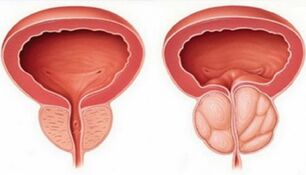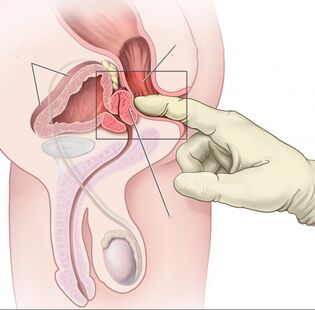Prostatitis is a disease that is unique to men. The disease begins with acute pain when urinating. This disease mainly affects those aged 35 and over. Medicine represents a wide range of medications for the treatment of chronic and acute prostatitis. However, the second case is difficult to handle. Therefore, when the first symptoms of the disease appear, you should consult a doctor.
Reasons for developing prostatitis
Prostatitis is a male disease that presents as acute or chronic inflammation of the prostate gland. The disease is observed at the age of 20 years. In boys, up to puberty, this pathology is extremely rare. Inflammation develops due to an infection that enters the prostate with urine. Sometimes the infection occurs through the wall of the rectum. By itself, the microflora can not cause disease.
Reasons leading to the development of prostatitis:
- long stay of a person in a sitting position;
- constipation;
- hypothermia;
- active sex life or lack thereof;
- mbipesha;
- alcohol abuse;
- radiation exposure;
- castration.
Prostatitis in older men leads to the development of cancer. There are both benign neoplasms in the form of adenoma and malignant hyperplasia. Men should undergo a medical examination at least twice a year to detect the disease in the early stages of development.
The importance of the prostate gland in children has not been studied. In an adult, he performs the following functions:
- liquefies sperm;
- ensures sperm viability;
- produces prostaglandins;
- provides shedding;
- prevents urine from entering the semen during ejaculation.

The prostate is surrounded by veins and ducts. Involves the walls of the urethra, bladder and seminal ducts in the inflammatory process. The situation is exacerbated by tissue edema due to the organ’s high blood supply. The prostate is well irritated, so the process of inflammation and urination causes severe pain.
Symptoms
Syndromes are difficult to diagnose due to course variability. The man has problems urinating. In this case, there is a sharp or pulling pain. The inflamed prostate increases in size. Bladder neck sclerosis develops. This process closes the ureter. Manifestation of different forms of prostatitis in men:
- Acute is characterized by severe inflammation in the prostate area. The man has a strong fever, body temperature reaches +38. . . + 39 degrees Celsius. There is pain in the groin and perineum. A person feels it not only when urinating, but also during the act of defecation.
- The chronic form is less disturbing than the acute one. Therefore, the signs may not appear immediately. Body temperature rises to +37 degrees Celsius. Sometimes mucus or pus is released when urinating. They are characteristic only of the chronic form of the course.
Symptoms are individual to each person, but some of them are common to all patients:
- urine flows slowly, sometimes urination occurs in drops;
- the power is off and the stool itself is delayed;
- feels incomplete emptying of the bladder;
- there is a frequent desire to use the toilet at night.
The daily urine volume of a healthy person is 1000-2000 ml per day. Desires are normal from 4-5 to 10-12 times. In case of disease, urine is not excreted in sufficient volume, so it accumulates in the bladder. When more than 350 ml are formed, a desire to empty is felt. Desire is increased by inflammation that irritates the bladder wall.
Sometimes patients have a small amount of blood in their urine. This phenomenon is rare, but quite dangerous. Internal bleeding is hard to stop. Occurs for the following reasons:
- Purulent vascular lesions in the ureter;
- trauma during examination of the urogenital tract;
- presence of carcinogenic growths.
Medications
The disease responds well to drug treatment in the early stages of development. Medication therapy should be comprehensive. The following agents are used to treat prostatitis:
- antibiotics;
- alpha-blockers;
- hormonal;
- muscle relaxants;
- medicines that stimulate immunity;
- rectal suppositories.
Drugs are prescribed for each person separately. The doctor takes into account the characteristics of the body, the nature of the inflammatory process and the hormonal background. Self-treatment of the disease will not give positive results. This will lead to the development of a chronic form, which is much more difficult to eliminate.
Antibiotics
Treatment of prostatitis is carried out mainly with antibacterial drugs. This is due to the fact that the disease most often has a bacterial flow. The drug is prescribed at the discretion of the doctor.If inflammation of the prostate glandis caused by blood stasis, then you do not need to take antibiotics.
These antibiotics have a broad spectrum of action. Along with blood flow, they enter the prostate gland. Reduces the presence of bacteria in organ tissues after the first application. The drug has bactericidal and bacteriostatic properties. Effective in the fight against acute prostatitis.
Alpha blockers
These drugs act on receptors in muscle cells in the bladder and prostate. Because of this, the tone of muscle and vascular tissue decreases. Smooth muscle relaxation results in urine flow and a reduction in inflammation.
The dose and course of therapy is determined by the attending physician after the examination.
Hormone therapy
The prostate gland is a hormone-dependent organ. To speed up the healing process, patients are prescribed hormonal drugs. They are able to reduce tissue inflammation, which facilitates blood and urine flow. Hormonal agents affect not only the prostate but the whole body as a whole. They can lead to unintended consequences if you do not follow your doctor's instructions.
Glucocorticoids are administered during the electrophoresis procedure. Hormone therapy helps restore glandular tissue and surrounding vessels.
Muscle relaxants
Anesthetic drugs are used to reduce muscle tone. They improve blood circulation and reduce the activity of the prostate gland.
Active substances are quickly absorbed into the bloodstream after taking medication. They reach the affected area and reduce the inflammatory response by reducing muscle tone. This therapy is beneficial for people with a sedentary lifestyle. Muscle relaxants help eliminate blood clots in the pelvis.
Stimulating immunity
During the acute course of the disease, the state of immunity is significantly reduced. Deteriorating not only the body's overall ability to fight infections, but also the local one. Because of this, prostatitis worsens.
Immunomodulators have immunostimulatory and antibacterial properties. Increases the body's ability to fight viruses, bacteria and fungi.
Rectal candles
Prostatitis medications are usually taken orally as pills or capsules. However, the disease requires long-term treatment and medications adversely affect the liver, kidneys and gastrointestinal tract. Therefore, rectal suppositories are used to provide general and local medical care. The advantage of this form is the direct effect on the tissues located near the prostate gland.
Treatment with folk remedies
Folk remedies are used to treat prostatitis at home.Such therapy should not replace drugs, it is used as an adjunct. It is possible to increase immunity thanks to beekeeping products. Honey has a high calorie content, rich in natural trace elements necessary for the body. You can add it to tea instead of sugar. People with diabetes mellitus or allergies to bee products should be wary of this product.
Pumpkin seed treatment for prostate:
- Peel 0. 5 kg of raw material and twist it in a meat grinder. Only raw seeds should be used.
- Add to them 200 g of honey. Stir this solution and make balls. They should be the size of a walnut.
- it is necessary to consume 1-2 pieces one hour before eating (store the product in the refrigerator).
Pumpkin seeds contain a large amount of zinc, which helps repair inflamed tissue.
Prostatitis can be treated with a hazelnut infusion:
- 1 tbsp. the leaves or bark of the plant should be boiled in a glass of boiling water.
- The container should be tightly closed with a lid and insist.
- 1/4 cup should be taken 4 times a day.
- it is also necessary to prepare a new soup each time to swallow.
Treatment of prostatitis with wormwood:
- The raw material must be sifted through a sieve. This herb is used for ingestion, and the rest is used for decoction.
- You should take a pinch 5-6 times a day.
- In the evening it is necessary to make microclists. For this, 1 tsp. dry wormwood should be diluted in 100 ml of boiling water.
- The composition should be cooled to +40 degrees Celsius and filtered.
- For an enema, use 50 ml of broth.
Wormwood helps with many diseases of the genitals and their ducts. Destroys a purulent infection. To complete the whole course, you will need 100 g of wormwood.You should not spill decoction on your urethra, as you may bring more infection into the body and complicate the course of the disease.The rectal mucosa is denser, so herbal enemas are allowed.
Prevention

Preventing prostatitis is about lifestyle changes. It is necessary to reduce alcohol intake, as well as to use contraception during sexual intercourse.
Preventive measures for prostatitis:
- Increase your physical activity throughout the day. People with a sedentary lifestyle need to get up every 60 minutes to warm up. This will allow normal blood flow to the lower back and pelvis.
- Spicy and fatty foods contribute to the development of prostatitis. You should refuse such food during an exacerbation of the disease.
- Increased sexual activity will reduce sperm stagnation. Accumulation of sperm leads not only to the development of prostatitis, but also to a decrease in strength and inflammation of the testicles.
- Hypothermia should not be allowed, especially in winter.
Internal prostate massage
Prostate massage can be done at home. Properly performed procedure stimulates blood flow to the gland and reduces its swelling. It is performed for prophylactic and therapeutic purposes.
Internal prostate massage:
- Take an anatomically comfortable position. The man lies on one side, bends his legs at the knees.
- Lubricate your finger with Vaseline and insert 5 inches into the anus.
- An inflamed prostate can be easily felt through the rectum. The body should be massaged with light movements.
- The procedure takes 1 minute, then you should start squeezing the gland.
- The finger should be pulled slowly out of the rectum so as not to damage the tissue mucosa.
- The duration of the whole procedure is 2-3 minutes.






























